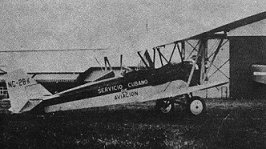
Compañía Cubana de Aviación (CCA). Cuba’s most important civil aviation company was founded October 8, 1929 as the Compañía Nacional Cubana de Aviación Curtiss, S.A., a subsidiary of North American Aviation. After a year of preparation, including personnel training, it began operating Cuba’s first regularly scheduled air transport service, flying daily over the 925 km between Havana and Santiago (with stopovers in Santa Clara, Morón, and Camagüey), on October 30, 1930. Later, another line was opened to carry passengers, cargo and mail to points in Oriente province. Pan American Airways acquired the airline on May 6, 1932, replaced its Curtiss Robin C-1 and Thrush aircraft with Ford Tri-motors, and dropped the word Curtiss from its name. In 1934 five Lockheed 10 Electras were acquired and service extended to Baracoa, Antilla, and Guantánamo. In 1945, Pan Am offered shares to the Cuban public, reducing its own holding to 52%. Nacional was dropped from the title in time for the first international route, to Miami, begun May 15, 1946 with new Douglas DC-3s. Douglas DC-4s providing Cubana’s first transatlantic service, to Madrid, via the Azores, on April 26, 1948, and to New York from May 1953. A Cuban syndicate headed by entrepreneur Jose López Vilaboy, secured control with 80% stockholding in 1953, the year the company acquired Havana’s José Martí International Airport. Pan Am withdrew completely on July 23, 1954, and although service was expanded to Mexico, Haiti and the Dominican Republic – giving a total of 17,210 km of international routes- the now wholly Cuban-owned airline had to strive hard to entice its largely American customers away from its U.S. rivals. Four Lockheed Super Constellations and 12 Curtiss C-46s were acquired in late 1954, and from 1955 Cubana began buying technically advanced turbo-prop Vickers Viscounts from Britain. Four long range Bristol Britannia for the Mexico City and New York routes followed in late 1958 but were made obsolete almost immediately by Boeing’s introduction of its first jets.
The line, which then flew some 10,995 route-miles (17,693 km) was confiscated and made a state-owned corporation in the May following the Revolution of 1959, but it rapidly fell into financial trouble – plans to buy its first two Boeing 707s had to be canceled and in September 1959 its assets in New York were seized for non-payment of debts. It had previously depended on subsidies from the Batista regime, deriving, it was alleged, from the gambling industry’s need to bring in American tourists. The Miami and New York services were terminated, and new connections established with eastern Europe. From February 1961 the Czechoslovak state airline began operating Cubana’s Britannia on the new weekly service between Havana and Prague, and in October the first Soviet aircrafts (Ilyushin 14s) were acquired. Five Ilyushin 18s (for the Guyana service) and 10 Antonov 24s (for domestic flights) were added to the fleet in 1966-1967. The first jet, a 186-seat Ilyushin 62, arrived in April 1972, for the weekly Madrid service. Passenger and cargo flights were both expanded: to Chile during the Unidad Popular administration of 1970-1973, and to East Berlin from April 1973. A weekly service from London’s Stanstead airport began in 1992, with a refueling stop at Gander, Newfoundland, on the outward journey. By 1994 its fleet consisted of 12 Antonov 24s, 24 Antonov 26s and 8 Yakolov 40s for short hauls and 9 Tubolev 154s, 2 Ilyushin 76s and 10 Ilyushin 62s for long distance, all Russian made. An order had been placed for five 300-seat Ilyushin 96-300s. Six years later some Fokker Friendship planes had also been acquired. Cubana continues to fly to several countries.








